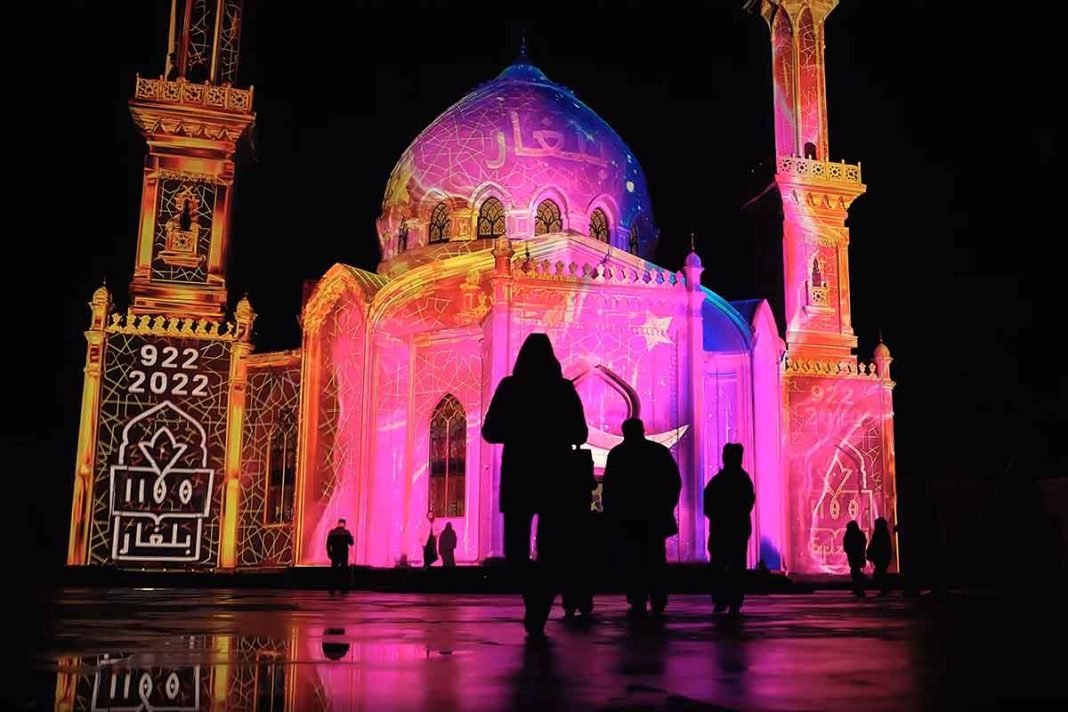Projection mapping is a technology that turns almost any object into a canvas, captivating the attention of viewers and passersby, and making it possible to bring a range of ideas to life, from commercial presentations to media art projects. One company that has its fair share of experience in the field is dreamlaser, which has a portfolio encompassing dozens of large-scale projects, including installations for media art festivals, projects for global companies, works for exhibitions and numerous projection shows.
“Mapping can take various forms,” began dreamlaser’s Creative Director, Anton Kolodyazhny, discussing the many applications of the medium – including architectural, “on buildings and structures like bridges, aeroplanes, and ships”; interior; on small objects “such as cakes, dresses, or building models”; landscape “on natural objects like mountains, cliffs, and trees”; and interactive “where viewers can interact with the projection using different technologies”.
According to Kolodyazhny, well-researched content is key to achieving meaningful projection mapping shows. “Content creation always begins with extensive research by our production team, and this is something we take particular pride in with our approach,” he commented. “Delving deep into the subject matter, studying its history and all available materials, conducting interviews with experts in the field – these form the foundation upon which we build our content creation process. Given our extensive work in cultural projects, we understand the importance of preserving the authenticity of cultural codes and finding suitable visual forms to represent them.”
One of the company’s most deeply researched projects was the mapping of the White Mosque in Bolgar, Russia. To commemorate the 1,100th anniversary of Volga Bulgaria’s adoption of Islam, dreamlaser utilised Notch Builder software as well as 12 Christie D4K40 projectors to create a 3D projection mapping, with hyper-realistic animation showcasing the building’s architectural beauty.
“The mapping visually explored themes of culture and religion in Volga Bulgaria,” Kolodyazhny recalled. “Consulting with historians and Arabic specialists, the visual concept was crafted to reflect Islamic traditions and local cultural imagery, with intricate patterns, colour schemes, symbols, and script elements drawn from cultural sources.”
Some of the most impressive examples of projection mapping emerge when creators take an unconventional approach. A notable instance is dreamlaser’s work at the Khareef Dhofar Festival in Oman, named after the annual monsoon bringing coolness to the arid region every summer.
“During this time, clouds gather over the desert, winds blow, rain falls, and greenery sprouts, creating a unique natural backdrop,” Kolodyazhny explained, recalling how the dreamlaser team utilised eight 30W lasers and 14 Panasonic PT-RZ31KE projectors to transform a huge dome-shaped stage on the edge of the misty desert into a canvas for ornamental and historical animations.
“Visually, the mapping in Oman was rich with images of the region’s culture and nature, including marine life, calligraphy, unique daggers, the moon, and stars vividly visible in the desert,” he added. “The semicircular structure not only served as a recognisable landmark at the festival but also provided a convenient surface for displaying intricate content. An-other innovative aspect was the real-time processing and projection of live performances by artists during the festival concert.”
As the capabilities of computer graphics continue to advance, the possibilities for telling rich stories featuring intricate details grows with it. Another of dreamlaser’s recent projects that made full use of this increasing capability was the show commemorating the 300th anniversary of Turkmen poet, thinker, and humanist, Magtymguly Fragi, who laid the foundation for the Turkmen literary language. In honour of this event, a grand inauguration of Fragi’s monument took place in Ashgabat at the foothills of the Kopetdag mountain range on the border between Turkmenistan and Iran.
“The show celebrated the life and legacy of the poet, using various symbols from local culture and nature. Spectators, along with the protagonist, journeyed through the mountains of Turkmenistan, culminating in arriving at the modern new city of Arkadag,” Kolodyazhny described. “The main stage for mapping was a majestic staircase adorned with massive granite bowls, illuminated by 130 multimedia projectors, including the advanced Christie D4K40 model. At the climax of the show, the staircase was rolled out with a bright carpet leading to the towering 60m sculpture of Magtymguly Fragi.”
From national celebrations and global events of international importance to sporting tournaments, corporate showcases and art installations, projection mapping is a versatile solution that can be deployed to achieve a range of effects. And with the region’s ever-increasing hunger for bigger, better and more eye-catching productions, it seems certain that the technology will continue to advance to keep up with the demand.
Photos: dreamlaser





